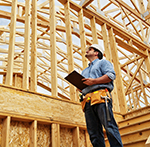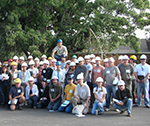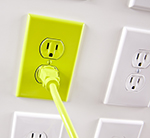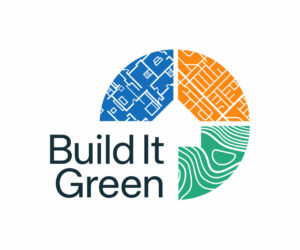Ten years ago when Build It Green was established, “green building” was a novel—and somewhat radical—approach to conventional construction practices. Builders and consumers were skeptical of its necessity, its price point and its design aesthetic.
Times have changed, and Build It Green has changed with them. While green building isn’t a fringe idea anymore, Build It Green continues to push for change that will reward building professionals for making green choices. As the organization celebrates its tenth anniversary as a nonprofit, we’re taking stock of our successes and looking ahead to what the future holds.
 Build It Green’s Fast Start
Build It Green’s Fast Start
Build It Green was the result of a 2005 merger between the nonprofit Green Resource Center, a trusted source of information on green building practices, and Bay Area Build It Green, a network of building industry professionals, local governments, manufacturers and suppliers. The alliance combined resources, expertise, and support from Bay Area local government agencies, especially StopWaste. Combining the two organizations would further their shared goals of transforming the California building industry to embrace green building.
“When we first introduced green building to the Bay Area,” says Build It Green Deputy Executive Director Bruce Mast, one of the organization’s founders, “we had to show people that green building didn’t mean you had to compromise on design, aesthetics, function, beauty, or durability. We also had to show that it was affordable—not just a luxury good.”
The passion of Build It Green’s founding members and organizations sparked a rapid expansion of green building services and resources. Build It Green was blazing new trails with its Ask an Expert hotline, Green Product Directory, Green Home Tours, professional guilds for learning and networking, green building guidelines and checklists, and professional trainings in green building fundamentals.
The Emergence of GreenPoint Rated
In concert with local governments like Sonoma and Contra Costa counties, a handful of forward-looking private sector builders, and the financial and technical resources of StopWaste, Build It Green launched its own green home certification program, GreenPoint Rated, in 2006. GreenPoint Rated’s easy-to-use checklist quickly took off and became the green standard for dozens of cities throughout the Bay Area. By 2008, GreenPoint Rated had certified 338 housing units. A year later, it had certified 898.
The Building Industry Association saw that Build It Green’s program was well-liked, builder-friendly, credible, and easy to use. In 2008, the Home Builders Association of Northern California (now Bay Area BIA) chose to endorse the program, and in 2009, the California Building Association recognized GreenPoint Rated over its own certification program.
“It was a big moment for us,” says Amy Dryden, Build It Green Senior Program Manager and one of the technical leads of the GreenPoint Rated program. “It was the first time a building association supported a green certification program, and it laid the groundwork for statewide green building standards down the road, which ultimately led to CALGreen.”
That same year, GreenPoint Rated certified 1,866 new and existing single-family and multifamily units, and 70 jurisdictions across the state referenced GreenPoint Rated. Build It Green’s education team expanded its green building science classes and rater trainings—classes that equipped building professionals with the skills to use resources more efficiently, save energy for their customers, and build more durable homes.
The program that had started with a handful of building pioneers was now state’s most trusted certification system, and hundreds of newly graduated Certified Green Building Professionals and Raters were sharing their newly acquired green knowledge with clients and colleagues.
 Moving with the Market
Moving with the Market
In 2008, major changes—good and bad—had a profound effect on the green building industry and Build It Green. Public perception started to turn more favorably toward green building, offering new opportunities for Build It Green to advance its mission. But then the housing bubble burst, and the construction industry went into a slump. At the same time, there was growing public awareness that climate change was a serious, existential threat to the nation’s prosperity and people’s health.
In response to these changing market forces, Build It Green refocused its efforts on improving building performance, as well as the bottom line. If Build It Green could demonstrate that it could build and improve a home to save energy, it could contract with utility companies who were looking to reduce their customers’ energy costs.
“Building professionals have always been a focus for us,” explains Dryden. “We’ve trained a lot of remodelers, and we’ve made a lot of progress showing that we can train the contractor community to upgrade homes and to measure energy savings from the work they’re doing.”
Over the years, Build It Green has leveraged its contractor expertise into a successful partnership with Pacific Gas & Electric’s Home Upgrade and AC Quality Care rebate programs, as well as initiatives with The Energy Network in Southern California. All of these programs encourage homeowners to make improvements to their homes, but the true ambassadors of the program are building professionals. “Even in the early days, we recognized that one building professional could reach a much larger network than a single consumer,” adds Dryden.
 BIG Accomplishments
BIG Accomplishments
Build It Green stays true to its roots by continuing to offer practical, market-friendly, “boots on the ground” solutions that help professionals adopt green practices and grow the market for efficient, healthy homes. Its commitment to its original mission—and its ability to adapt to changing market forces—has resulted in some impressive impacts.
GREENPOINT RATED
GreenPoint Rated is still California’s most trusted home rating system. The program has surpassed 38,000 certified units, with more than 7,000 of them in 2015. Those homes have saved an impressive amount of energy, water, and carbon emissions—the equivalent of 142,000 tons of CO2 (that’s like taking 100,000 cars off the road or eliminating the energy use of 47,000 homes).
TRAINING & EDUCATION
Across the state, more than 6,000 members of the building industry—from contractors and architects, to building officials and interior designers—are Certified Green Building Professionals. Another 1,315 individuals have delved deeper into the green certification process to become GreenPoint Raters or Advisors.
REAL ESTATE OUTREACH
Build It Green helped to design and launch a groundbreaking real estate training and certification initiative in 2011. Through 2015, Build It Green has trained more than 1,000 real estate professionals throughout California on the basics of green building and green labels, green financing, and how to help clients undertake energy retrofits. This year, Build It Green began training appraisers how to quantify the value of green features through a partnership with the Appraisal Institute. In just two training sessions, Build It Green has graduated 107 appraisers from the program.
 Tackling the BIG Challenges Ahead
Tackling the BIG Challenges Ahead
Green building has moved from obscurity to a significant trend in the construction market.
But there’s still work to be done. Below are some of the challenges that Build It Green is already beginning to address as it looks forward to its next ten years as an organization:
BUILDING ZERO ENERGY HOMES
“When we first started Build It Green, Net Zero Energy wasn’t even a thing,” says Mast. “We had this idea that it would be really great if we made a green home and made it visible and quantifiable. Now we’ve moved beyond that.
This year, GreenPoint Rated added a Zero Net Energy (ZNE) designation to its certification program—the first green certification program in the country to do so. There are multiple ZNE projects in progress, with the first two expected to be completed by the end of the year, representing 110 multifamily and single-family homes.
“We know we can build Zero Energy new home and upgrade existing homes,” adds Mast. “We need to demonstrate that we can do that cost effectively and on a mass scale.”
BUILDING ZERO CARBON HOMES
Zero energy isn’t the end of the road. Zero carbon is the next frontier. In the future, Build It Green hopes to address and quantify the use of residential electric vehicle charging stations and appliances that don’t rely on fossil fuels for power, as well as explore ways to bring energy storage and load shifting technologies into homes.
PREDICTING ENERGY SAVINGS
Green building practitioners will be challenged to accurately predict future performance and minimize risk to the homeowner or occupant. The writing is already on the wall for real-time performance measurement: California Governor Jerry Brown recently signed AB-802, which directs the CPUC to offer energy efficiency programs based on measured savings at the utility meter. At the federal level, the House and Senate have approved legislation that incorporates “Pay for Success,” which authorizes HUD to enter into performance-based agreements to save energy and water. Build It Green is working on new techniques to measure and demonstrate success.
SHOWING GREEN VALUE
To affect lasting change in the green building industry, it’s critical to show that there are measurable benefits to green building besides energy savings. “We need to show that a high-performance home is a higher value home, and that a green home is a healthy home that has tangible benefits, and that we’re saving healthcare dollars. We can show that a green home is a more durable home, and that you should save money on your insurance policy because of that.”
Build It Green has been working with the real estate community on the value of green homes going back to 2008, and that work will set the stage for a more transparent and seamless flow of information from home owners who have performed home upgrades to the home buyers who are increasingly demanding these features.
“We’re always looking for win-win solutions,” says Mast. “We believe that we can save the planet and improve our quality of life and our health and save money for your pocketbook.”


Alex Coba
Communication Associate
As a proud California native from Stockton, Alex brings a wealth of experience and a versatile skill set. He has a solid communication background with a Bachelor of Arts in Journalism and Public Relations from California State University, Chico. Alex is adept at strategic communications and media relations, with experience gathering and sharing stories from his local communities that uplift the unique spirit and values of those places. He is excited to join Build It Green, where he can apply his talents to further BIG’s mission to help communities across California thrive